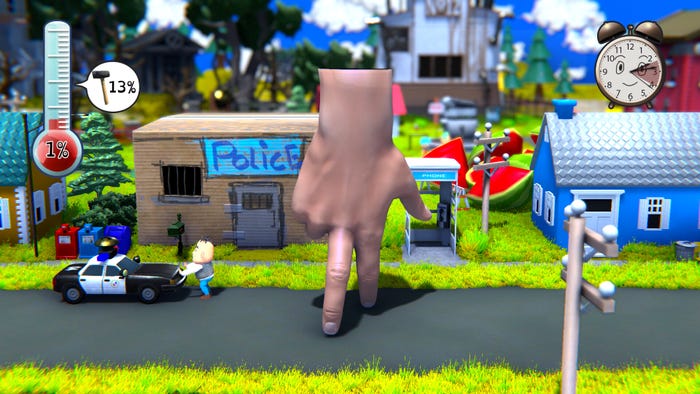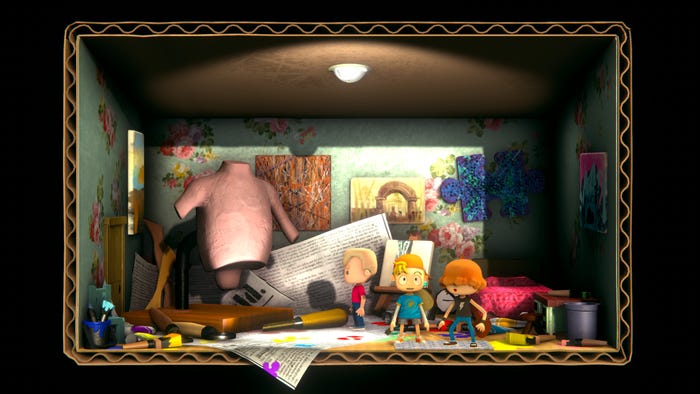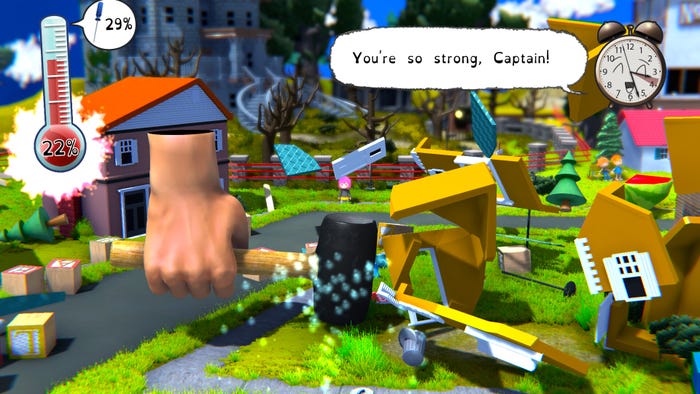Trending
Opinion: How will Project 2025 impact game developers?
The Heritage Foundation's manifesto for the possible next administration could do great harm to many, including large portions of the game development community.
Game director Max Ponoroff tells us how he was inspired by Mister Rogers' Neighborhood and a strange urge to wreck his own creations.

Starstruck: Hands of Time sees you digging out old Guitar Hero guitars to play tunes and becoming a giant hand that smashes a hand-crafted city of popsicle sticks and cardboard.
Game Developer caught up with Max Ponoroff, the game’s director, to talk about what appealed to them about offering musical and destructive gameplay styles in the same game, how the developer’s own strange urge to wreck what they created resulted in the ridiculous giant hand segments, and how inspirations from Mister Rogers' Neighborhood would help shape the game’s world.
Game Developer: Starstruck: Hands of Time mixes music-based action and interaction with causing destruction as a huge hand. What inspired this unique mixture of play styles? Why merge music and destruction in your story?
Max Ponoroff: The idea with Starstruck's gameplay was to allow the player to experience a single, unified, interesting worldview from the different perspectives of each of the three protagonists. And because each protagonist has a different perspective, the gameplay differs between them.
In the past, there were more games that were designed along these lines, having a single world that you explore from the perspectives of multiple different protagonists, each with different gameplay. For example, many games in the SaGa series, Sonic Adventure, and even MOTHER 3. In more recent times, Nier: Automata has developed this way of doing things even further.
They say that there are three main components to a film: characters, world, and story. The same might apply to story-based video games. Given the interactive and real-time nature of video games, it makes a lot of sense to me for a video game to focus more on their worlds than films do, since video games seem suited, by their nature, to revealing the nature of their worlds in a nonlinear way from multiple perspectives.

Image via Createdelic.
Was this mixture always what you had in mind? How has Starstruck changed (or stayed the same) throughout development?
Ponoroff: Originally, the game was going to just be a story-based rhythm game. However, after the graphics for the town were created, I felt the urge to destroy it all and knock everything around. From there, the rest of the ideas began to take shape, and it became clear how they would connect with the different characters' perspectives.
Rhythm is threaded through a great deal of the game. What thoughts went into the game's music-playing system? What drew you to make it feel similar to games like Guitar Hero and Rock Band?
Ponoroff: There are two significant differences between Starstruck and other guitar rhythm games: it's a horizontal rhythm game instead of a vertical one, and the notes remain stationary on the screen instead of moving.
The primary thought behind these choices was to make sure that the player's eyes would always be moving across the screen as they played the songs. The reason I wanted this was so that players would catch glimpses of the background visuals while playing the songs, because these visuals often are there to help develop the characters and story. This kind of thing is only necessary to worry about in a story-based rhythm game, which is why you don't see arcade-style rhythm games working this way. But you do see it in games like Starstruck, PaRappa the Rapper, and K-ON! Ho-kago Live!!, which are all ultimately trying to bring everything back to the story and/or characters.

Image via Createdelic.
Starstruck allows players to hook up a variety of old guitar controllers to play the game. What appealed to you about that idea? What challenges did this create in getting so many varied controllers to work with the game?
Ponoroff: This was something I implemented due to popular demand from players after I released the demo. There's a huge community of people who still play various games with these controllers, and they work pretty well for this type of gameplay, so it seemed like a natural fit. Honestly, the biggest challenges with this feature were with Unity, as I needed to switch the game's input system from Rewired to the Unity Input System in order to support control remapping.
You designed a variety of different challenge levels for players with the rhythm gameplay. Can you tell us a bit about the thoughts behind the design of each of the difficulty levels?
Ponoroff: One of the good things about creating a rhythm game is that there are people out there with a lot of knowledge and skills in making charts. I actually originally created the charts for the game's demo myself, but honestly, they weren't that good, so I sought the help of a charter named Chezy from the rhythm game community. Chezy made the charts with the commonly accepted conventions of this type of rhythm game in mind, including the various difficulty levels.
What thoughts went into the music that went into the game? What sort of audio style and music genres felt right for this experience in exploring life as a pair of guitarist protagonists in a handmade world?
Ponoroff: I thought it was important for the music to feel handmade and not entirely digital In order to drive home the game's concepts and world. For this reason, whenever possible we used live instruments and vocals. And also for this reason, I thought it was important to incorporate many different genes of music. All of this was only possible because I happened to be working with Andrew Allanson as the game's lead composer, who was always ready to explore unusual, challenging ideas and then hit a home run with each of them. In the end, I think all the factors came together to result in a high quality soundtrack.

Image via Createdelic.
Much of Starstruck has a handmade visual style, the game filled with claymation characters and popsicle stick and cardboard buildings. What drew you to this style? Can you tell us about the work that went into designing it?
Ponoroff: The art style was designed by Brian Allanson, the lead artist for the game. We researched vintage model train sets, miniature dioramas, and that type of thing in order to come up with the basic concepts together, and then Brian took it from there and created the models. In order to create the textures for some models, Brian even took photos of real life objects like cotton balls and popsicle sticks.
Can you walk us through how you designed the game's vibrant city? From concepts to its final shape in the game?
Ponoroff: Starstruck adapts its gameplay loop from the American TV show Mister Rogers' Neighborhood. Half of that show takes place in Mister Rogers' neighborhood, a realistic American suburb, and the other half takes place in a mysterious surreal world called "The Neighborhood of Make-Believe", an imaginary place that Mister Rogers invites the viewer to visit with him. Like Mister Rogers' Neighborhood, Starstruck is based on traveling back and forth between two places: The Captain's realistic-looking spaceship and the miniature diorama neighborhood, the "Neighborhood of 20XX". Because of this, some observant players might notice that the Neighborhood of 20XX has some interesting visual homages to Mister Rogers' Neighborhood.
After hand crafting this style, can you tell us about how you made it feel so satisfying to break things while playing as the giant hand? How did you capture that feeling of childhood creativity and smashing your creations with the giant hand moments?
Ponoroff: This was a long trial and error process—the sort that I'm sure every game developer has been through. Ultimately, it came down to trying out different ideas and seeing how players reacted to them by watching them play the game over Discord and talking with them afterwards about what felt good and what didn't.

Image via Createdelic.
What ideas went into the various tools and ways the hand would wreck things? What do you feel they added to the game?
Ponoroff: In the end, I think the most critical aspect of the hand gameplay sections ended up being the humor. Starstruck uses a lot of visual comedy, and one book that really helped me in working on that was Too Funny For Words by Ollie Johnston and Frank Thomas.
What do you hope players take away from playing Starstruck?
Ponoroff: It's an undeniable fact of this world that not everyone can be at the top of the pyramid. This is just one of those ugly truths that nobody really wants to face or talk about. I think every modern person is probably troubled by cognitive dissonance related to this question on some level. Within a single school day, a student might be taught both that everyone is equal, and also that life itself owes its very existence to, and is therefore defined by, the process of survival of the fittest (and by implication the erasure of the losers).
How do we make sense of this? As the world rapidly becomes more and more bifurcated with each passing year, this question becomes more and more important, even in daily life. I hope that everyone who plays Starstruck can find some benefit from the examination of this question.
You May Also Like